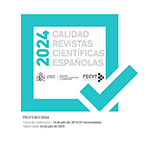Aproximación al concepto de observatorio editorial: recomendaciones para su creación
Resumen
El concepto de ‘observatorio’ se ha interpretado y utilizado de diferentes maneras. Su conceptualización es reducida y no se tiene una caracterización, lo que afecta la percepción y la credibilidad que proyecta como instrumento. Este artículo presenta los resultados de una aproximación al concepto de observatorio editorial que permite determinar algunas de sus principales características y, sobre esa base, proponer recomendaciones para su creación. Se diseñó una metodología de investigación documental de alcance exploratorio y descriptivo. Se buscaron y recopilaron 66 fuentes bibliográficas; de ellas, se codificaron 25 mediante el software atlas.ti 8. Para ello, se crearon tres redes semánticas agrupando 146 códigos, con el fin de responder a las preguntas ¿qué es un observatorio?, ¿qué hace? y ¿para qué lo hace? Así, se construyeron 20 categorías para caracterizar los sitios web de tres observatorios editoriales existentes. Como resultado, se encontró que un observatorio se concibe, mayoritariamente, como un ‘espacio’ o ‘lugar; y que sus principales acciones se relacionan con ‘analizar’ y ‘evaluar’ la ‘toma de decisiones’ y el ‘seguimiento a las políticas’. La caracterización realizada a través de los sitios web evidenció las tensiones, las dificultades y las incertidumbres que existen entre la conceptualización y la implementación de los observatorios editoriales analizados. Asimismo, la presente investigación contribuye con la generación de conocimiento para que se puedan fortalecer, diseñar o implementar observatorios editoriales, los cuales no deben competir o replicar esfuerzos; su identidad está llamada a brindarle un valor más alto a la información para fortalecer la producción de nuevo conocimiento.
Descargas
Descarga artículo
Licencia
La Revista General de Información y Documentación, para fomentar el intercambio global del conocimiento, facilita el acceso sin restricciones a sus contenidos desde el momento de su publicación en la presente edición electrónica, y por eso es una revista de acceso abierto. Los originales publicados en esta revista son propiedad de la Universidad Complutense de Madrid y es obligatorio citar su procedencia en cualquier reproducción total o parcial. Todos los contenidos se distribuyen bajo una licencia de uso y distribución Creative Commons Reconocimiento 4.0 (CC BY 4.0). Esta circunstancia ha de hacerse constar expresamente de esta forma cuando sea necesario. Puede consultar la versión informativa y el texto legal de la licencia.











